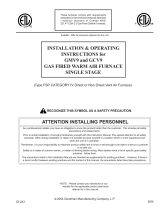
16
DIRECT VENT TERMINAL CLEARANCES
OTHER THAN DIRECT VENT TERMINAL CLEARANCES
v
V
X
1 In accordance with the current CSA B149.1, Natural Gas and Propane Installation Code.
2 In accordance with the current ANSI Z223.1/NFPA 54, National Fuel Gas Code.
† A vent shall not terminate directly above a sidewalk or paved driveway that is located between two single family dwellings and serves
both dwellings.
‡ Permitted only if veranda, porch, deck or balcony is fully open on a minimum of two sides beneath the floor.
* For clearances not specified in ANSI Z223.1/NFPA 54 or CSA B149.1, the following statement shall be included:
“Clearance in accordance with local installation codes and the requirements of the gas supplier and the manufacturer’s installation instruction.”
1 In accordance with the current CSA B149.1, Natural Gas and Propane Installation Code.
2 In accordance with the current ANSI Z223.1/NFPA 54, National Fuel Gas Code.
† A vent shall not terminate directly above a sidewalk or paveable driveway that is located between two single family dwellings and serves
both dwelling.
‡ Permitted only if veranda, porch, deck or balcony is fully open on a minimum of two sides beneath the floor.
* For clearances not specified in ANSI Z223.1/NFPA 54 or CSA B149.1, the following statement shall be included:
“Clearance in accordance with local installation codes and the requirements of the gas supplier and the manufacturer’s installation instruction.”
Canadian Installations
1
U.S. Installations
2
I= Clearance to sevice
regulator vent outlet. 3 ft. (91 cm). *
J= Clearance to nonmechanical air
supply inlet to building or the
combustion air inlet to any other
appliance.
6 in. (15 cm) for appliances 10,000
Btuh (3 kW), 12 in. (30 cm) for
appliances > 10,000 Btuh (3kW) and
100,000 Btuh (30 kW), 36 in. (91 cm)
for appliances > 100,000 Btuh (30 kW).
4 ft. (1.2 m) below or to side of
opening; 1 ft. (300 m) above opening.
K= Clearance to a mechanical
air supply inlet. 6 ft. (1.83 m) 3 ft. (91 cm) above if within
10 ft. (3 m) horizontally.
L= Clearance above paved sidewalk or
paved driveway located on public
property.
7 ft. (2.13m) † 7 ft. (2.13m)
M= Clearance under veranda, porch,
deck or balcony. 12 in. (30 cm) ‡ *
Canadian Installations
1
U.S. Installations
2
I= Clearance to service
regulator vent outlet. 3 ft. (91 cm). *
J= Clearance to nonmechanical air
supply inlet to building or the
combustion air inlet to any other
appliance.
6 in. (15 cm) for appliances 10,000
Btuh (3 kW), 12 in. (30 cm) for
appliances > 10,000 Btuh (3kW) and
100,000 Btuh (30 kW), 36 in. (91 cm)
for appliances > 100,000 Btuh (30 kW).
6 in. (15 cm) for appliances 10,000
Btuh (3 kW), 9 in. (23 cm) for
appliances > 10,000 Btuh (3kW) and
50,000 Btuh (15 kW), 12 in. (30 cm) for
appliances > 50,000 Btuh (15 kW).
K= Clearance to a mechanical
air supply inlet. 6 ft. (1.83 m) 3 ft. (91 cm) above if within
10 ft. (3 m) horizontally.
L= Clearance above paved sidewalk or
paved driveway located on public
property.
7 ft. (2.13m) † *
M= Clearance under veranda, porch,
deck or balcony. 12 in. (30 cm) ‡ *
Canadian Installations
1
U.S. Installations
2
A= Clearance above grade,
veranda, porch, deck or
balcony. (See 1.24.6-i(9)b.)
12 in. (30 cm) 12 in. (30 cm)
B= Clearance to window or
door that may be opened. 6 in. (15 cm) for appliances
10,000 Btuh (3 kW), 12 in. (30 cm) for
appliances > 10,000 Btuh (3 kW) and
100,000 Btuh (30 kW), 36 in. (91 cm)
for appliances > 100,000 Btuh (30
kW).
4 ft. (1.2 m) below or to side of
opening; 1 ft. (300 m) above opening.
C= Clearance to permanently
closed window. **
D= Vertical clearance to ventilated soffit
located above the terminal within a
horizontal distance of 2 feet (61 cm)
from the center line of the terminal.
**
E= Clearance to unventilated soffit. * *
F= Clearance to outside corner. * *
G= Clearance to inside corner. * *
H= Clearance to each side of center
line extended above meter/regulator
assembly.
3 ft. (91 cm) within a height 15 ft.
(4.5 m) above the meter/regulator
assembly.
*
Canadian Installations
1
U.S. Installations
2
A= Clearance above grade,
veranda, porch, deck or
balcony. (See 1.24.6-i(9)b.)
12 in. (30 cm) 12 in. (30 cm)
B= Clearance to window or
door that may be opened. 6 in. (15 cm) for appliances
10,000 Btuh (3 kW), 12 in. (30 cm) for
appliances > 10,000 Btuh (3 kW) and
100,000 Btuh (30 kW), 36 in. (91 cm)
for appliances > 100,000 Btuh (30
kW).
6 in. (15 cm) for appliances
10,000 Btuh (3 kW), 9 in. (23 cm) for
appliances > 10,000 Btuh (3 kW) and
50,000 Btuh (15 kW), 12 in. (30 cm) for
appliances > 500,000 Btuh (15 kW).
C= Clearance to permanently
closed window. **
D= Vertical clearance to ventilated soffit
located above the terminal within a
horizontal distance of 2 feet (61 cm)
from the center line of the terminal.
**
E= Clearance to unventilated soffit. * *
F= Clearance to outside corner. * *
G= Clearance to inside corner. * *
H= Clearance to each side of center
line extended above meter/regulator
assembly.
3 ft. (91 cm) within a height 15 ft.
(4.5 m) above the meter/regulator
assembly.
*

























